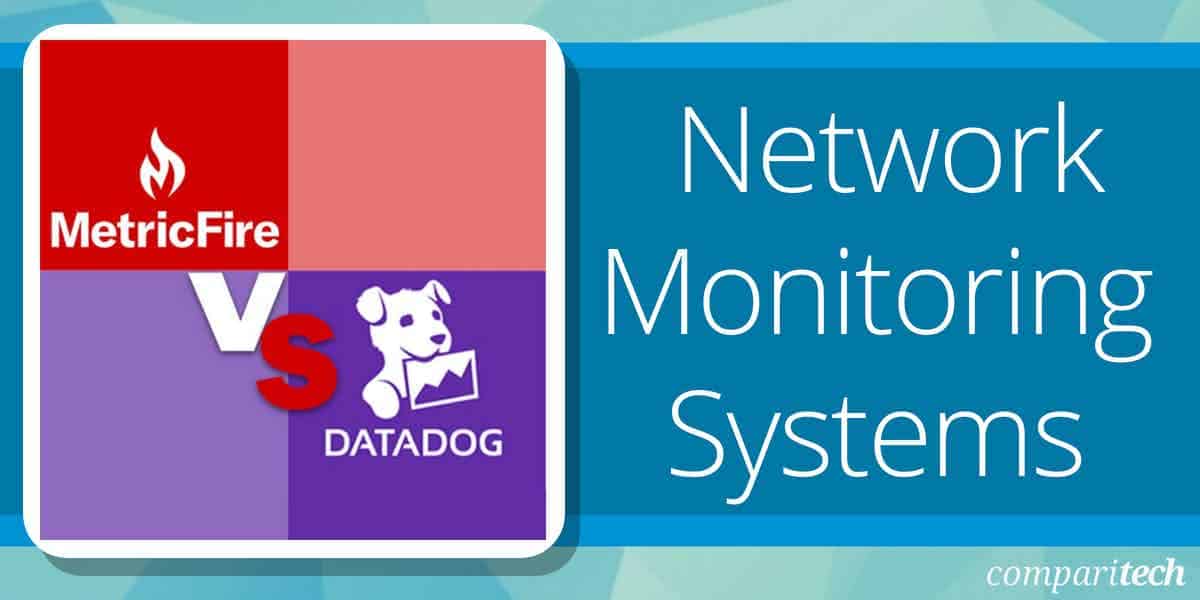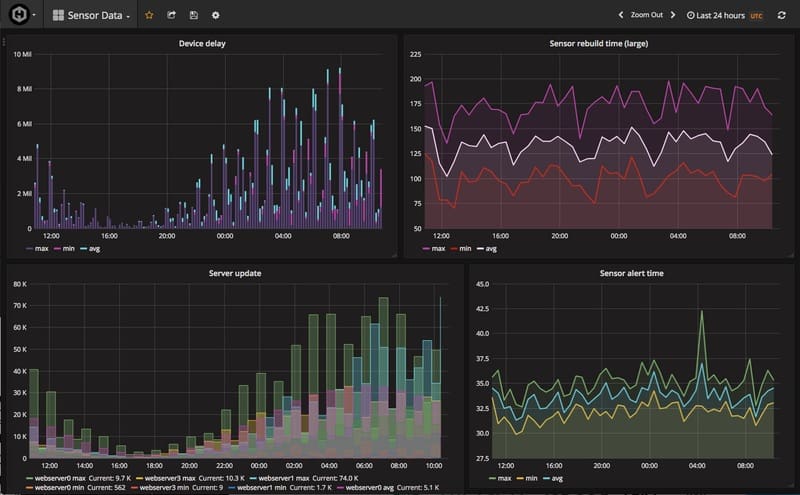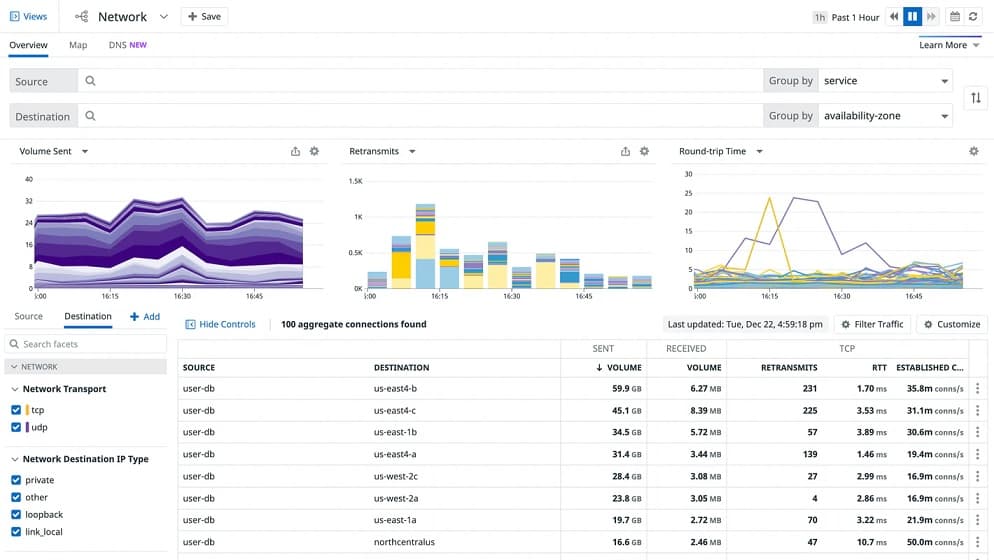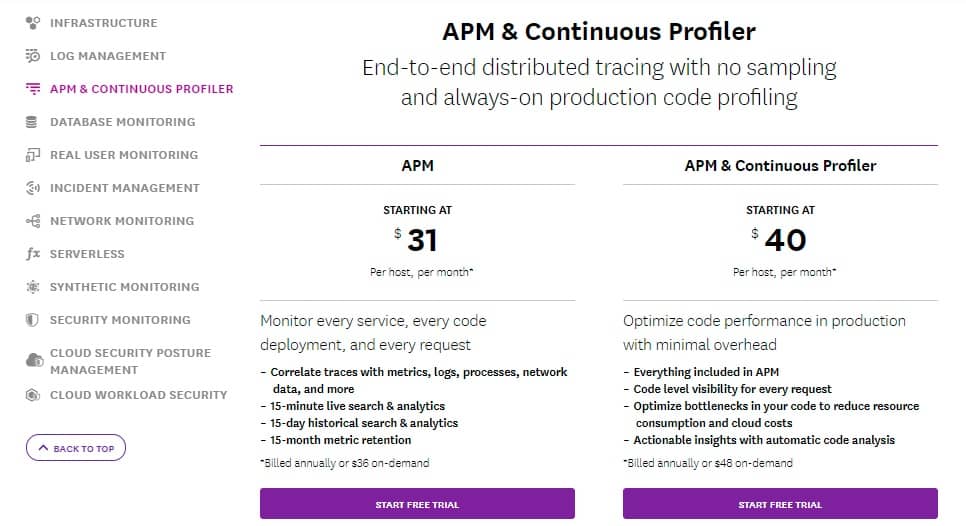MetricFire and Datadog are two cloud-based system monitoring services. Both services are of similar age and have expanded and evolved rapidly over the last decade. Both of these systems offer live system monitoring, performance analysis, and security event logging.
If you are looking for a new monitoring system for your network and endpoints, you might consider both of these services. In this review, we look at MetricFire and Datadog and assess the strengths and weaknesses of each.
MetricFire highlights
MetricFire was started up in 2012 in Dublin, Ireland, by Dave Concannon and Charlie von Metzradt – two developers who created the monitoring system themselves. Originally the concept behind the business was to take an open source monitoring system and offer it as a hosted service. So, the main innovation that the company provided was the hosting and management of the pre-existing Graphite software. Thus, the company was initially called Hosted Graphite.
Key Features:
- Hosted Monitoring Solutions: Specializes in hosting and managing open-source monitoring software for hassle-free operations.
- Dual Monitoring Systems: Provides two distinct monitoring systems, Graphite and Prometheus, to suit diverse needs.
- SaaS Model: Offers its services in various plans tailored to accommodate different traffic volumes, enhancing scalability.
Over time, the founders added other software to their managed platform. These additional packages are StatsD, Grafana, and Prometheus. None of these software packages were created by the pair. However, they are all open-source systems, which means that they can be adjusted. The Hosted Graphite owners changed and enhanced these services to orchestrate and provide a coordinated service.
With a more excellent bundle of software, the company changed its name to MetricFire. The founders of MetricFire still run the business. However, they sold the company to Xenon Partners, a private equity firm, in September 2019.
Pros:
- Comprehensive Open-Source Suite: Delivers a full suite of open-source tools, including Graphite, Prometheus, StatsD, and Grafana, for a robust monitoring solution.
- Rich API Integrations: Features extensive API integrations, allowing for seamless connections with other software and services.
- User-Friendly Visualizations: Employs simple yet powerful graphs and visuals to convey data insights effectively.
- Ideal for SMBs: The service structure and pricing make it particularly suitable for small and medium-sized businesses.
Cons:
- Steep Learning Curve: Requires a significant investment of time to master the functionality of each open-source platform included in the service.
The underlying components of MetricFire provide live system monitoring and log analysis. The company offers two alternative packages: Hosted Graphite and Hosted Prometheus. The price for each service is the same. These two packages do more or less the same work in monitoring networks and endpoints. However, the slight differences between them make them suitable for different types of businesses.
Datadog highlights
Datadog started business in 2010. Its two founders are still with the company as CEO and CTO. However, the company is now listed on NASDAQ – it was recorded in September 2019. Datadog is a much larger company than MetricFire, and it has more than 2,600 employees worldwide.
Key Features:
- Broad Monitoring Capability: Offers a comprehensive suite for security and system performance monitoring across various platforms.
- DevOps Support: Includes testing services for CI/CD pipelines, equipped with bug trackers to enhance software development processes.
- Incident and Log Management: Features advanced incident management and log management modules for thorough IT operations oversight.
Like MetricFire, Datadog is a cloud-based system that started with someone else’s code. The Datadog monitoring system was written initially for Server Density in Python and was acquired in 2009. After using and adapting that monitoring program for nine years, the Datadog team rewrote the whole package in Go.
Many of the backend components of Datadog are open-source systems. These include Apache Cassandra and PostgreSQL. So, there are a lot of similarities in the background of MetricFire and Datadog. However, the two approaches diverge in the way their present their services.
Datadog offers monitors specifically packaged for networks, servers, infrastructure, Web services, or applications. In addition, through the acquisition of smaller specialist companies, Datadog has recently been able to add on more services. These include a Log Management system and a Security Monitoring service.
Pros:
- Customizable Dashboards: Provides highly configurable dashboards, enabling users to tailor the monitoring interface to their needs.
- Cloud-Based Solution: Delivers monitoring as a SaaS product, eliminating the need for server deployments and minimizing onboarding expenses.
- Auto-Discovery Feature: Automatically generates network topology maps, offering dynamic insights into network configurations.
- Real-Time Updates: Ensures that any changes within the network are updated almost instantly, keeping data current.
- Scalable Monitoring: Facilitates the ability to scale monitoring efforts with flexible pricing, accommodating businesses of varying sizes.
Cons:
- Limited Trial Period: An extended trial period would be advantageous for a more comprehensive assessment of the platform’s capabilities.
Other services from Datadog include Synthetic Monitoring and Real User Monitoring services for website performance. The company has recently added an Incident Management module for help desk squads and an Error Tracking system for development teams. The company is moving beyond the typical network, server, and application monitoring services into development lifecycle support and system management. The monitoring tools have extended into highly specialized services for serverless systems.
MetricFire vs Datadog head-to-head
MetricFire offers two separate packages; however, both have the same price, and both feed through to the same frontend. Both MetricFire and Datadog are SaaS packages that include storage space for collected system data.
System interface
The MetricFire platform offers Grafana for a frontend – Grafana is a fork of Kibana. Whether you choose the Prometheus or Graphite service, you would channel through to the same frontend. However, you can choose to add on a different interface.
Assessing MetricFire’s interface depends on how you choose to set up the system and which frontend you choose. However, the Grafana interface is presentable and easy to read. In addition, it includes graphical representations of data that let you see changes in throughputs and performance over time.
The Datadog system is more cut-and-dried. The service includes its dashboard, and you would use that by default. Datadog can be implemented through APIs, so if you have your interface preferences, you could easily feed Datadog data through to a different frontend, such as Kibana. However, few system managers would have time to do this, and there is little incentive to customize your system because the Datadog interface offers all of the services you need.
System monitoring
Although both Datadog and MetricFire produce system monitoring tools, a quick look at the sites shows a vast difference between the two. Datadog is a system monitoring package that competes with services offered by SolarWinds, Paessler, and ManageEngine. It is a cloud-based version of the monitoring systems that you get from those leading providers.
A subscriber to the Datadog system signs up for a plan, sets up account details, and then follows instructions to download a data collecting agent onto each system that is being monitored. After that, the dashboard gets automatically populated with records for each device connected to the network, and different details appear for each device that you choose to monitor – the dials and graphs in the dashboard suddenly become alive. Finally, the monitoring system is operating, and after checking on the pre-set alert thresholds, you can close the console and get on with other tasks.
MetricFire is quite a different matter. Looking through an explanation in the MetricFire website that explains the difference between the Graphite and Prometheus services, you will probably be perplexed. You can’t get up and running in minutes with MetricFire the way you can with Datadog.
MetricFire doesn’t download an agent onto your system and get started. Instead, you have to search out a data collector and set it up yourself to get data fed into the monitoring system. This is a much more complicated process than the service offered by Datadog.
MetricFire isn’t a plug-n-play service like Datadog. Instead, it is a toolkit from which you can assemble your monitoring package. You need to have the time and interest to play around with the components and customize your monitoring service to use the MetricFire system.
MetricFire vs Datadog: price
MetricFire offers seven plans. The difference between them lies in the number of monitored metrics and the number of alert thresholds that are required. The data retention period and the number of users allowed are other factors in the plan pricing.
Although seven plans sound complicated, the purpose of these different editions is to make the service more attractive to businesses of various sizes.
MetricFire applied a formula when arriving at these plans and prices with a price contribution for the length of data retention, another for the number of users, etc. By picking specific values for these variables, MetricFire makes it easier for potential customers to estimate their costs correctly. In addition, as plan subscriptions have to be paid for in advance, a buyer needs to work out their volume requirements precisely.
The MetricFire pricing policy is more buyer-friendly than services that don’t publish prices but invite interested parties to contact them for a quote.
The Datadog price list is also published – which is excellent. However, working out the price that a customer will end up paying is very complicated. For a start, Datadog has many types of services and editions for each. Some editions have a series of plans, while others just have one base price. In all cases, the buyer is shown a starting price for the project and is only presented with price-increasing volume expansion options during the final purchase screens.
There are 12 pages in the price list for Datadog. Here is the price page for the Application Performance Monitor service.
Each Datadog package is a subscription service, and the starting price advertised for each edition is based on annual payment plans. It is possible to get a month-to-month plan, but the charge rate will be higher. You pay for the whole subscription period upfront.
Datadog has slimmed down its packages and the pricing options that it presents for each. This dramatically simplifies the buyer’s journey. Don’t think that each package is a separate service. By combining packages, you get extra services because the underlying monitoring systems are interconnected.
Suppose you take the APM and Infrastructure plans. In that case, you benefit from the dependency mapping service that links together related applications from the APM. Still, you also get that dependency chain reaching down to the server and on through to the virtual platform (if one exists) and down to network events.
MetricFire vs Datadog: Evolution
The security services offered by Datadog are new and still in the Beta phase. These look as though they will expand the business in a completely new direction. The log management service offered by the company is much easier to conceptualize than the data collection and management services of MetricFire, which show the capacity to provide users with a data source for them to compose a similar service for themselves.
MetricFire is moving towards more usability from its original service. While Datadog is diversifying, MetricFire progresses from a loose collection of utilities towards a more packaged service.
MetricFire and Datadog free trials
Both MetricFire and Datadog offer free trials. However, the MetricFire free trial is more a sales rep-driven demo. The Datadog free trial lasts for 14 days and gives you access to all the service’s modules. This is an excellent opportunity to work out the capacity of monitoring systems that you will need before you approach the buying process.
MetricFire vs. Datadog: the verdict
MetricFire is suitable for businesses that want to create their customized monitoring system. The hosted service offers a menu of utilities that an individual can stitch together with programming skills, a development team with a project manager, and a transparent system design.
You could use the services of MetricFire to create a log management system or even your security monitoring package.
Datadog’s services are already set up and are very easy to get started. However, you still need to assemble a custom package by deciding which modules you want to use. With the Datadog service, you don’t need to define or program the data exchanges between modules. Instead, all of that interaction and integration is automatically implemented behind the scenes.
To conclude, if you want an off-the-shelf monitoring system, choose Datadog; if you are looking for a toolkit that will enable you to build a system monitoring package yourself, use MetricFire.








